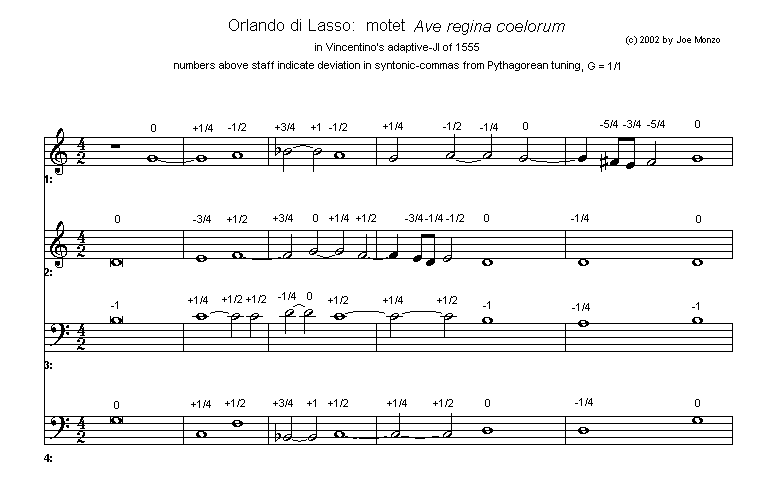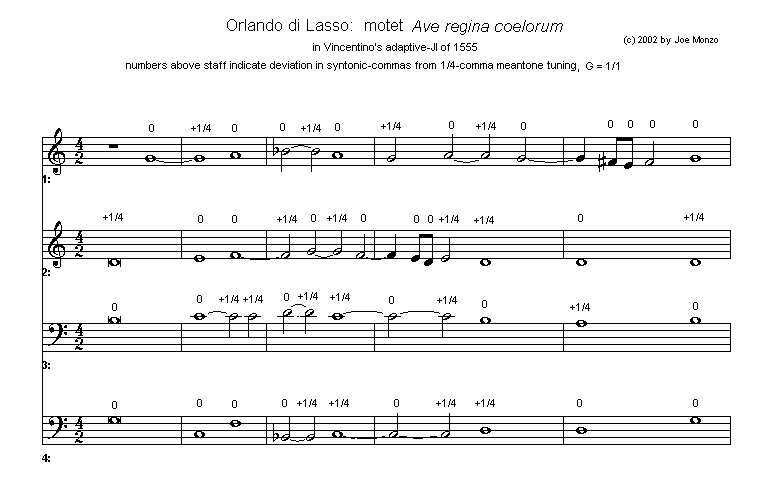Vicentino's "2nd tuning of 1555" is composed of two chains of 1/4-comma meantone, the first one a 19-tone chain from Gb to B#, which can be closely approximated by a 19-tone subset of 31edo, and the second a 17-tone chain from Gb to A#, 1/4-comma higher than the first chain.
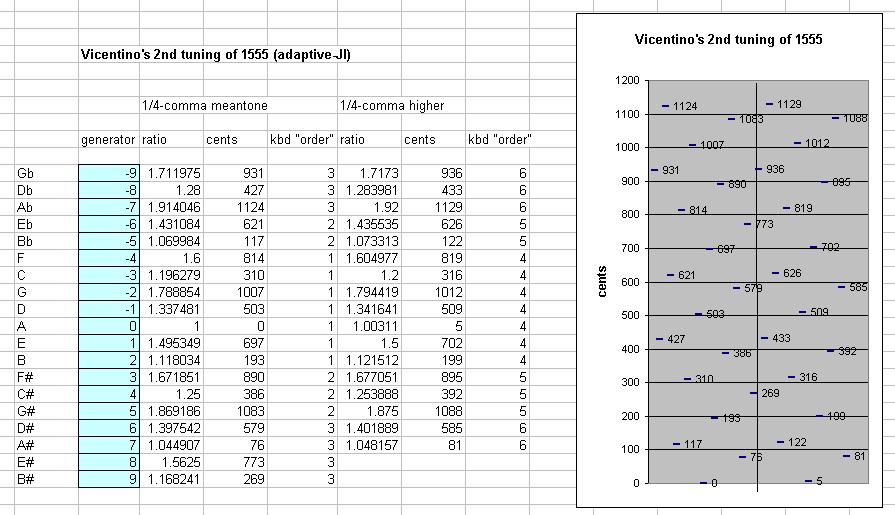
here's a rectangular lattice-diagram of Vicentino's "2nd tuning of 1555"; the 3-axis is horizontal, the 5-axis is vertical and the pitches indicate exponents which increase by increments of 1/4. notes a "5th" apart (3:2 ratio) which have integer exponents of 5 are connected by dashed lines. Approximate cents-values are given after the note-names.
B# 269
E# 773-----
A# 76
D# 579 A# 81
G# 1083 D# 585
C# 386-----G# 1088
F# 890 C# 392
B 193 F# 895
E 697 B 199
A 0-----E 702
D 503 A 5
G 1007 D 509
C 310 G 1012
F 814-----C 316
Bb 117 F 819
Eb 621 Bb 122
Ab 1124 Eb 626
Db 427-----Ab 1129
Gb 931 Db 433
Gb 936
the 19-tone "first chain" is the column on the left-hand side of this lattice.
the generator "5th" in 1/4-comma meantone can be factored as 5^(1/4), thus 4 steps of the generator (i.e., 4 "5ths") is exactly 5^1, which represents the 5:4 ratio; thus, 4 "5ths" = a "major-3rd", the basic equation of meantone, which is only approximately true in other variants belonging to the meantone family of temperaments, but is exact here in 1/4-comma MT. thus, on the lattice, a chain of 1/4-comma meantone goes straight up and down the 5-axis.
Vicentino's second chain, 1/4-comma higher than the first chain, thus ends up being in effect a 3:2 higher than the first chain, as the lattice shows in the right-hand column. Thus, it is an adaptive-JI which provides a great number of vertical sonorities which are in exact 5-limit just-intonation, but without the problems of commatic drift, since it is based on meantone.
here's an attempt at redrawing the same lattice in triangular format:
B# 269
E# 773 ----------
A# 76 '.
D# 579 '. A# 81
G# 1083 '. D# 585
C# 386 ------------- G# 1088
F# 890 '. C# 392
B 193 '. F# 895
E 697 '. B 199
A 0 ---------------- E 702
D 503 '. A 5
G 1007 '. D 509
C 310 '. G 1012
F 814 -------------- C 316
Bb 117 '. F 819
Eb 621 '. Bb 122
Ab 1124 '. Eb 626
Db 427 ------------- Ab 1129
Gb 931 Db 433
Gb 936
the lattices show that the following triads are exactly in tune to low-integer proportions:
Major = 4:5:6
Gb, Db, Ab, Eb, Bb, F, C, G, D, A, E, B, F#, C#, G#
minor = 1/(6:5:4)
eb, bb, f, c, g, d, a, e, b, f#, c#, g#, d#
here is the whole scale. i'd have to do some reading to find out Vicentino's notation, so i'll just use a plus sign to designate the 1/4-comma-higher note of each like-named pair.
note ~cents {3,5}-vector 12edo note w/ cawapus
Ab+ 1129 [1 -8/4] G#/Ab +1201
Ab 1124 [0 -7/4] G#/Ab +981
G#+ 1088 [1 4/4] G#/Ab -481
G# 1083 [0 5/4] G#/Ab -701
G+ 1012 [1 -3/4] G +501
G 1007 [0 -2/4] G +280
Gb+ 936 [1 -10/4] F#/Gb +1482
Gb 931 [0 -9/4] F#/Gb +1261
F#+ 895 [1 2/4] F#/Gb -200
F# 890 [0 3/4] F#/Gb -420
F+ 819 [1 -5/4] F +781
F 814 [0 -4/4] F +561
E# 773 [0 8/4] F -1121
E+ 702 [1 0/4] E +80
E 697 [0 1/4] E -140
Eb+ 626 [1 -7/4] D#/Eb +1061
Eb 621 [0 -6/4] D#/Eb +841
D#+ 585 [1 5/4] D#/Eb -621
D# 579 [0 6/4] D#/Eb -841
D+ 509 [1 -2/4] D +360
D 503 [0 -1/4] D +140
Db+ 433 [1 -9/4] C#/Db +1341
Db 427 [0 -8/4] C#/Db +1121
C#+ 392 [1 3/4] C#/Db -340
C# 386 [0 4/4] C#/Db -561
C+ 316 [1 -4/4] C +641
C 310 [0 -3/4] C +420
B# 269 [0 9/4] C -1261
B+ 199 [1 1/4] B -60
B 193 [0 2/4] B -280
Bb+ 122 [1 -6/4] A#/Bb +921
Bb 117 [0 -5/4] A#/Bb +701
A#+ 81 [1 6/4] A#/Bb -761
A# 76 [0 7/4] A#/Bb -981
A+ 5 [1 -1/4] A +220
A 0 [0 0/4] A 0
below is an interval matrix of Vicentino's adaptive-JI:
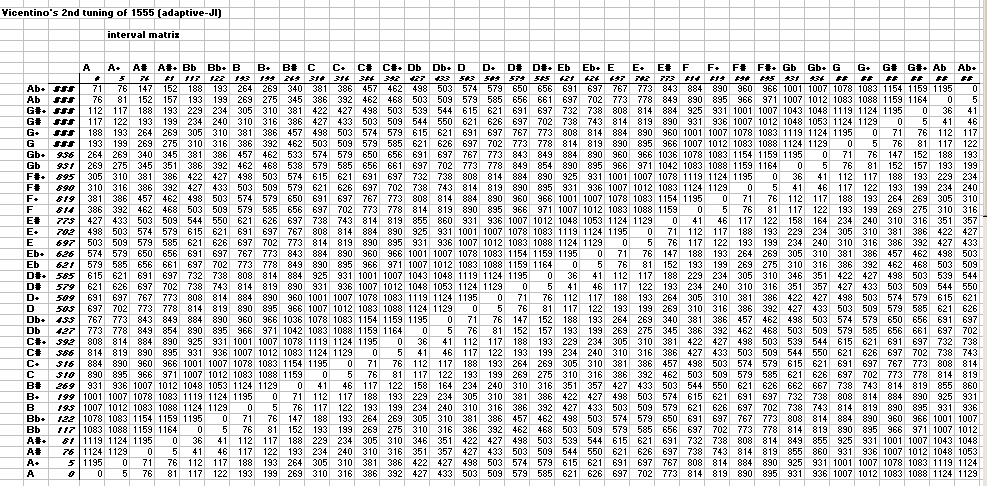
just out of curiosity i analyzed what intervals might approximate the 7:4 ratio (~969 cents). here's the list:
~971 cents:
Gb : E+
F : D#+
Eb : C#+
Db : B+
C : A#+
Bb : G#+
Ab : F#+
~966 cents:
G : E#
Gb+ : E+
Gb : E
F+ : D#+
F : D#
Eb+ : C#+
Eb : C#
D : B#
Db+ : B+
Db : B
C+ : A#+
C : A#
Bb : G#
Bb+ : G#+
Ab+ : F#+
Ab : F#
The graphic below shows the 36-out-of-217edo approximation of Vicentino's tuning. With a maximum error of ~2 cents, which is nearly half the difference between Vicentino's two chains, 217edo was chosen less because of its accuracy than because of the fact that, as 7 bike-chains of 31edo, each higher than the last by 1 degree of 217edo (which is close to 1/4 of a comma), its structure resembles that of Vicentino's tuning so well; therefore, a 36-tone subset of 217edo (19 tones from the first 31edo bike-chain, plus 17 tones from the next bike-chain above it) can work on the same principles as those of Vicentino's actual tuning.
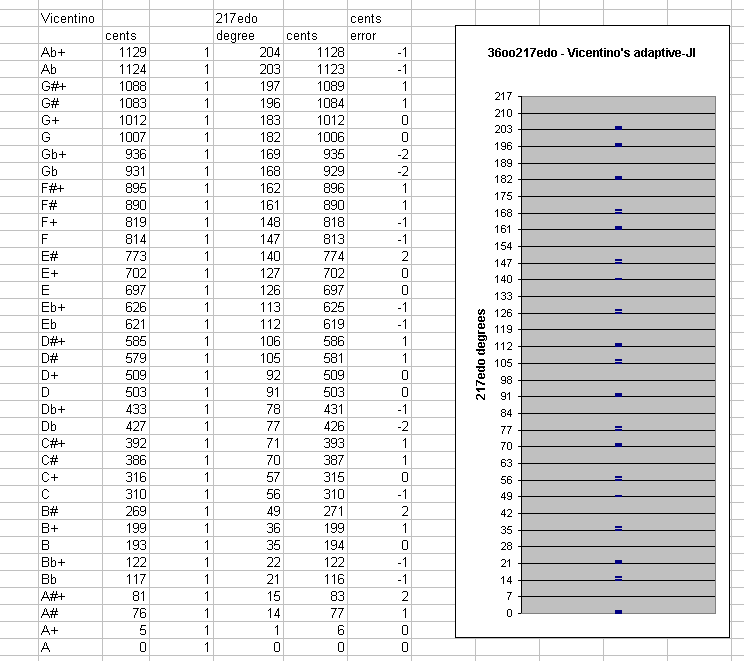
217edo provides, among other things, an excellent set of pitches to achieve fixed-pitch adaptive-JI. A subset of 217edo which consists of 2 bike-chains of 31edo, approximately 1/4-comma apart, provides a good approximation to Vicentino's tuning. (See below, on Margo Schulter's and Paul Erlich's 62-tone proposals.)
Below is an example by Dave Keenan of a I-VI-II-V-I
"comma-pump"
chord progression, written in the "sagittal" notation
developed by he and George Secor in 2002, and tuned
by me in 217edo (click on the graphic to hear the MIDI-file).
Below are two musical illustrations of the first 5 measures of
Orlando di Lasso's motet Ave regina coelorum, tuned
in Vicentino's adaptive-JI tuning. This example was chosen
because it is used as an illustration by Easley Blackwood
of the unsuitability of strict-JI for "common-practice" repertoire
(see Blackwood 1985, p 133-135). The first illustration uses
Pythagorean tuning
as the basis for the letter-names and
accidentals, and
shows the deviation of Vicentino's tuning from Pythagorean.
The second illustration uses
1/4-comma meantone
as the notational basis and shows the deviation of Vicentino's
tuning from that. [click on the illustration
to hear a MIDI-file of it]
REFERENCEs
Vicentino, Nicola. 1555.
L'antica musica ridotta alla moderna prattica
["ancient music restored to modern practice"]
Antonio Barre, Rome. republished 1557.
English translation:
- Ancient music adapted to modern practice
Maria Rika Maniates (ed.), Claude V. Palisca (ed.),
Yale University Press, New Haven CT, 1996, p. xlix.
Blackwood, Easley. 1985.
The Structure of Recognizable Diatonic Tunings
Princeton University Press, Princeton, NJ.
ISBN 0-691-09129-3

